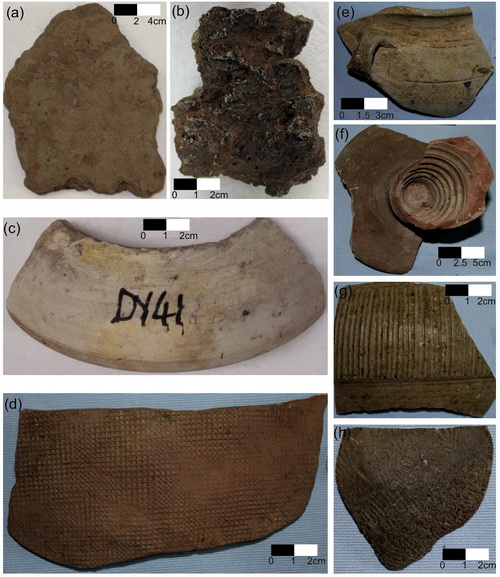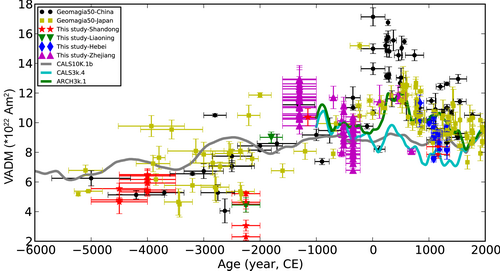Geomagnetic field variations from 8 kyr of Chinese historyUpdate time:06 05, 2014
The geomagnetic field is generated by the motion of Earth’s fluid outer core and its variation is driven by internal dynamics, hence the behavior of geomagnetic field has significant implications for geodynamics. The geomagnetic field varies over a broad range of timescales. To understand the variation over periods of thousands of years we rely entirely on measurements of remanent magnetization from geological and archaeological materials. Archaeomagnetic data from Eastern Asia, however, are sparse, particularly those that would be widely regarded as reliable. The majority of previous archaeomagnetic work in China was mainly carried out in the 1980s and 1990s and the published results are scattered. This scatter might reflect genuine behavior of the geomagnetic field caused by non-dipolar components, or inaccuracies in age models, poor data quality caused by lack of modern experimental techniques and poor selection criteria or a combination of the two factors. China is located at one of the largest magnetic anomaly centers in the world, the Eastern Asian magnetic anomaly center, and nearby the flux patch moving around the North Pole, which makes the variation of geomagnetic field here quite important. The longevity of Chinese civilization and the abundance of archaeological artifacts make archaeomagnetic studies within China an important tool for filling in many gaps in our current data sets. In this study, we have carried out paleointensity experiments on 918 specimens spanning the last ~7 kyr, which includes pottery fragments, baked clay, and slag collected from Shandong, Liaoning, Zhejiang, and Hebei Provinces in China. Approximately half of the specimens yielded results that passed strict data selection criteria and give high-fidelity paleointensities. The virtual axial dipole moments (VADMs) of our sites range from ~2´1022 to ~13´1022 Am2. At ~2250 BCE our results suggest a paleointensity low of ~2´1022 Am2, which increases to a high of ~13´1022 Am2 by ~1300 BCE. This rapid (less than 1000 years) six-fold change in the paleointensity may have important implications for the dynamics of core flow at this time. Our data from the last ~3 kyr are generally in good agreement with the ARCH3k.1 model, but deviate significantly at certain time periods from the CALS3k.4 and CALS10k.1b models, which is likely due to differences in the data used to constrain these models. At ages older than ~3 ka, where only the CALS10k.1b model is available for comparison, our data deviate significantly from the model. Combining our new results with the published data from China and Japan, we provide greatly improved constraints for the regional model of Eastern Asia. When comparing the variations of geomagnetic field in three globally representative areas of Eastern Asia, the Middle East and Southern Europe, a common general trend of sinusoidal variations since ~8 ka is identified, which is likely dominated by the dipole component. However, significant disparities are revealed as well, which we
Fig. 1 Various samples analyzed in this study: (a) baked clay from Shandong, (b) slag from Zhejiang, (c) porcelain fragment from Hebei, (d-h) pottery fragments with different shapes and decorations from Zhejiang.
Fig. 2 Regional model of virtual axial dipole moments (VADMs) in Eastern Asia. Black solid circles/yellow squares are the accepted published data in China/Japan from
This study has been published in Earth and Planetary Science Letters(Cai et al. Geomagnetic intensity variations for the past 8 kyr: New archaeointensity results from Eastern China. Earth and Planetary Science Letters, 2014, 392: 217-229). Link: http://www.sciencedirect.com/science/article/pii/S0012821X14001113
|
Contact
Related Articles
Reference
|
-
SIMSSecondary Ion Mass Spectrometer Laboratory
-
MC-ICPMSMultiple-collector ICPMS Laboratory
-
EM & TEMElectron Microprobe and Transmission Electron Microscope Laboratory
-
SISolid Isotope Laboratory
-
StIStable Isotope Laboratory
-
RMPARock-Mineral Preparation and Analysis
-
AAH40Ar/39Ar & (U-Th)/He Laboratory
-
EMLElectron Microscopy Laboratory
-
USCLUranium Series Chronology Laboratory
-
SASeismic Array Laboratory
-
SEELaboratory of Space Environment Exploration Laboratory
-
PGPaleomagnetism and Geochronology Laboratory
-
BioMNSFrance-China Bio-mineralization and Nano-structure Laboratory

 Print
Print Close
Close


